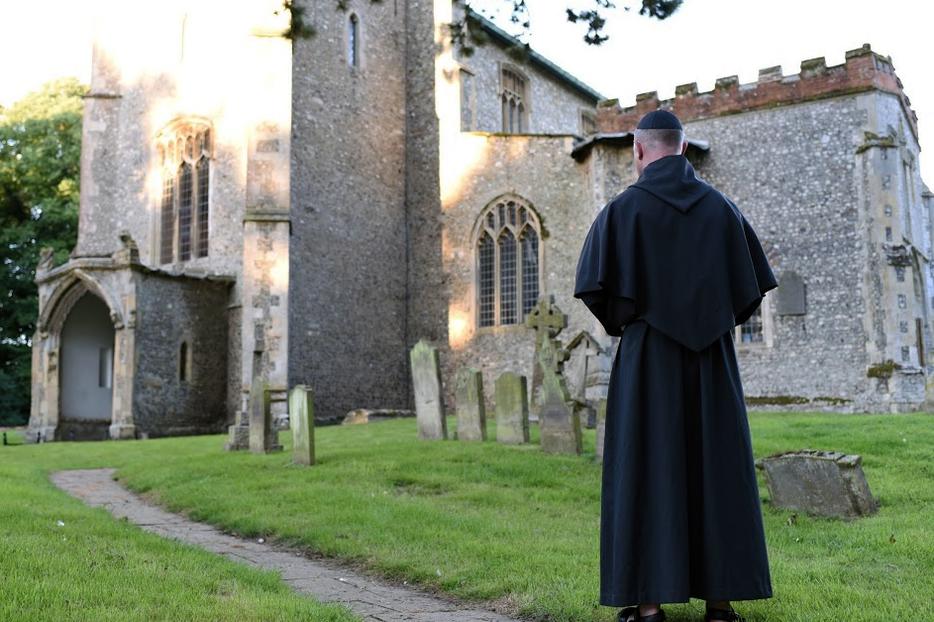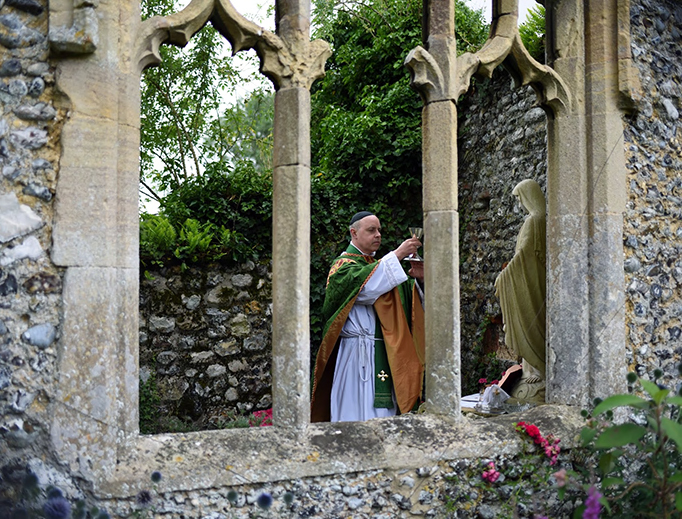After Centuries of Exile, a Grey Friar Returns to Walsingham
Once more at Walsingham Friary, if now to an open sky, the Blessed Sacrament was held aloft.

If you have ever visited Walsingham, England’s National Marian Shrine, you may have seen the poignant sight of a ruined friary standing upon a small hill just outside the village. It forms part of a private property now, and so is not normally accessible to the public.
At the entrance gate, one July day, there stood a figure dressed in dark gray, a member of the Order of Friars Minor Conventual, more commonly known as Grey Friars. This was the order that used to live and worship at the Walsingham Friary centuries earlier.
The Grey Friar in question was Fr. James Mary. Each day of his Walsingham pilgrimage, he would stand at the gate that leads to the ruins. He would gaze upon the ruined friary offering supplication for the friars buried there, and also for those who had caused the destruction of this once holy place. He also offered a unique prayer for a specific intention: namely that, one day, the Grey Friars would return to Walsingham.
Upon his arrival in the village, I had noted this friar. With Fr. James Mary, it was immediately observable how he talked to everyone and anyone he met, to say nothing of his gift for disarming even the most confirmed atheist. There was the woman who owns a local teashop. No believer, she was obviously so charmed by the tall, gentle friar who came each day for coffee that when the friar offered to bless her shop, she agreed. Perhaps she thought: ‘Why not?’ The day after she had something to tell the friar. He could ‘bless her shop any day’ because following its blessing, the teashop had enjoyed its busiest custom yet.
It was not just shops that were blessed; souls were touched. I saw pregnant women upon the street having their unborn babies very gently but very publicly blessed. Seemingly, no one refused Fr. James Mary’s offer to impart a blessing. Some, I know, were non-believers; some were Anglicans; many were Catholics.
It is a unique privilege to be with a truly apostolic priest; to be alongside a man who has no agenda other than to win souls for Christ; no ambition other than to draw all to the Mediatrix of all Graces and, by so doing, bring all to a better knowledge of Her Son. Over the days that followed, I lost count of the number of times I came across the friar coming from or going to hear someone’s confession. Here was a pastor who saw all too distinctly the many ills besetting us but also the remedies given us, namely the Sacraments.
This was never more clearly witnessed than when Fr. James Mary said Holy Mass. Nothing was added, nothing taken away from the ritual. Here was a priest who knew the true ‘artistic’ vocation of his consecrated hands: namely, to offer the Holy Sacrifice, the source and summit of the Christian life.
It would have been easy, for some at least, to dismiss such a man as a naïve innocent. A few minutes conversation with the priest, as with any true priest, would soon disabuse the impartial observer of such a notion, however. As with Chesterton’s fictional Father Brown, innocence is not destroyed through exposure to other men’s evils. Often, in a curious way the innocence of priests is enhanced by disclosure of sin by way of the confessional, renewed even.
That summer morning when I met Fr. James Mary praying at the gate and pondering the ruins of his ‘former home’, I sensed instinctively the one thing he desired most. I asked him if I was right in my surmise; he admitted that it was so. In fact, it was something he longed for on visiting Walsingham.
In the 16th century, it was Henry Tudor who decided to erect his own church. It was Thomas Cromwell and his henchmen who used this as an excuse to pillage the ancient monasteries and friaries of England. Now, for the first time since the break with Rome, the current occupants of a house built from and in the ruins of the former friary are Catholic. So, I asked them for permission; they graciously agreed. A plan was hatched. A time set. Word soon spread among those who might be interested.
As the friar was leaving on the coming Sunday, it had to be that morning or not at all, and regardless of the weather forecast: heavy rain.
So that Sabbath morn, under somber if still rain-free skies, there processed a small company of laymen and women, some religious sisters, young and old, some physically fit, others less so. At their head, there walked a Grey Friar carrying an alb, a chasuble and a stole.
That morn the wind blew pure white clouds across sapphire skies as candles were lit and the ancient words began to be spoken. Soon after, while the early morning light fell upon the broken stones of the former friary, a bell rang out. Once more at Walsingham Friary, if now to an open sky, the precious Species was held aloft.
The Reformation has come and gone. So too have many other revolutions and wars, dynasties and empires. The remains of the friary have endured all these as the pages of history kept turning. Now its walls were witnessing a return of sorts. Just a short way from where the Holy Sacrifice was offered lies the unmarked graves of the friars who lived there many centuries ago. Some died martyrs. It is no exaggeration to say that while Mass was being offered on that summer day in 2017, there was present another communion, altogether different but just as real. On that day, both seen and unseen were gathered in one act of witness.
After offering Holy Mass, the Grey Friar made his way back to the village before onward to places far from Walsingham. While watching him leave, and almost as softly as the wind upon the ancient stones all around, I heard a voice somewhere say: ‘I have a feeling he’ll be back…’
Curiously, later upon returning to the EWTN studios in the heart of Walsingham village, I glimpsed something for the first time. At the studio’s center, as part of a set-decoration, there stood a small statue. Looking at it properly for the first time, I realized it was a depiction of another Grey Friar, and one now ‘resident’ in Walsingham: St. Maximilian Mary Kolbe, a patron — and a protector — for all in Catholic media.
(Note: On Sept. 24 2017, the Feast of Our Lady of Walsingham, EWTN will broadcast Holy Mass live from the Shrine at Walsingham.)













